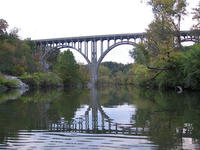-
Groundbreaking tests to offer better understanding of post-earthquake fires
Post-earthquake fires are a well-known and serious hazard, but very little is known about the performance of fire protection systems in earthquakes; groundbreaking tests to be conducted next week are aimed at better understanding of the effects of earthquakes on building systems designed to suppress or prevent the spread of fires
-
-
McAfee, Intel collaborate on protecting energy infrastructure

McAfee and Intel will collaborate on improving the protection of the world’s energy utilities, including generation, transmission, and distribution, from increased cyber attacks; the two companies have provided a blueprint for a comprehensive solution of multiple products which create layers of security and operate together without great complexity or without impacting availability
-
-
Fears of cyber espionage hinder U.S. license to China Mobile
Serious concerns over cyberspying have fueled a debate among U.S. national security agencies about whether communications giant China Mobile should be granted a Federal Communications Commission (FCC) license to provide international service to American customers
-
-
Calibrating volume of U.S. petroleum flow
Per capita consumption of petroleum in the United States is ten liters per day; there are 300 million people in the United States, so this means that three billion liters, or about nineteen million barrels, of petroleum are moving around across the United States in pipelines, waterways, roads, and rails each day; with crude oil priced around $100 a barrel, this comes to about $2 billion worth of petroleum
-
-
Using nanomaterials to build safer, longer-lasting roadways
Asphalt is now made from petroleum, so it is very expensive; researchers tested two types of nanoclays, adding 2-4 percent by weight to asphalt; this is a smidgeon — less than half of a percent of the total weight of the asphalt pavement itself, but it made a big difference, and could make for safer, longer-lasting roadways
-
-
Protecting U.S. bridges from terrorism, accident
More than 600,000 bridges in the United States are 20-feet long or longer, some over a century old, many of them national iconic monuments; DHS, the Federal Highway Administration, and the U.S. Army Corps of Engineers are conducting a series of tests aiming to make the bridges better able to withstand a terrorist attack; this research is discovering how materials, connection details, and designs in aging bridges react to IEDs, other explosives, kinetic impact, intense fires, and other accidents
-
-
New tool offer better flooding protection
There are more than 84,000 dams across the United States, and millions of Americans live behind them; if these dams and levees were to fail and unleash catastrophic flooding, as some did in New Orleans in 2005, a high price will be paid in life lost and property destroyed; DHS S&T and partners develop new software systems for fast simulation of catastrophic flooding
-
-
Five arrested in foiled Cleveland bridge bomb plot

Five men who considered themselves anarchists and angry at the government and corporate America were arrested after a foiled attempt to blow up a Cleveland area bridge; the five were planning on commemorating May Day, the international workers’ holiday, by destroying the bridge connecting two wealthy Cleveland suburbs
-
-
Slowing time as a way to counter cyberattacks
Researchers offer a new way to deal with cyberattacks on critical infrastructure like power and water utilities and banking networks: slow down Internet traffic, including the malicious code, when an attack is suspected; this would allow networks time to deal with the attacks
-
-
Maintaining bridges and improving safety on a budget
What if there was a way to improve the safety, durability, and sustainability of aging bridges across North America without increasing spending? Researchers say they have found a way to do so
-
-
Humble bacteria help create self-healing concrete

Scientists use a ground-borne bacteria — bacilli megaterium — to create calcite, a crystalline form of natural calcium carbonate; this can then be used to block the concrete’s pores, keeping out water and other damaging substances to prolong the life of the concrete
-
-
Sensing technology helps prevent construction accidents
Researchers have developed a system that employs remote sensing technology to improve safety on construction sites by using tracking tags to monitor movements in real-time
-
-
Cyberattack disrupts Iran’s oil production system
The Iranian oil industrywas subject to cyber attack this past weekend,but the Iranian government saysit has contained and controlled the damage from the malware; this is the fourth known cyber attack on Iran’s civilian and military infrastructure
-
-
New Iowa bridge equipped with damage-detection gauges
A new Iowa bridge is equipped with sensors which provide a large amount of quantitative information about the bridge’s performance and condition; these gauges take 100 readings a second for corrosion, strain, surface conditions, moisture within the steel arch, and structure movements over time; the bridge is also equipped to monitor the security of the structure and to record surveillance video; it is a structure monitoring model that could be used for other new bridges, including much larger ones
-
-
Identifying the sources of global sea level rise
As the Earth’s climate warms, a melting ice sheet produces a distinct and highly non-uniform pattern of sea-level change, with sea level falling close to the melting ice sheet and rising progressively farther away. The pattern for each ice sheet is unique and is known as its sea level fingerprint; now, geophysicists have found a way to identify the sea level fingerprint left by a particular ice sheet
-
More headlines
The long view
Falling Space Debris: How High Is the Risk I'll Get Hit?
An International Space Station battery fell back to Earth and, luckily, splashed down harmlessly in the Atlantic. Should we have worried? Space debris reenters our atmosphere every week.
Using Drone Swarms to Fight Forest Fires
Forest fires are becoming increasingly catastrophic across the world, accelerated by climate change. Researchers are using multiple swarms of drones to tackle natural disasters like forest fires.
